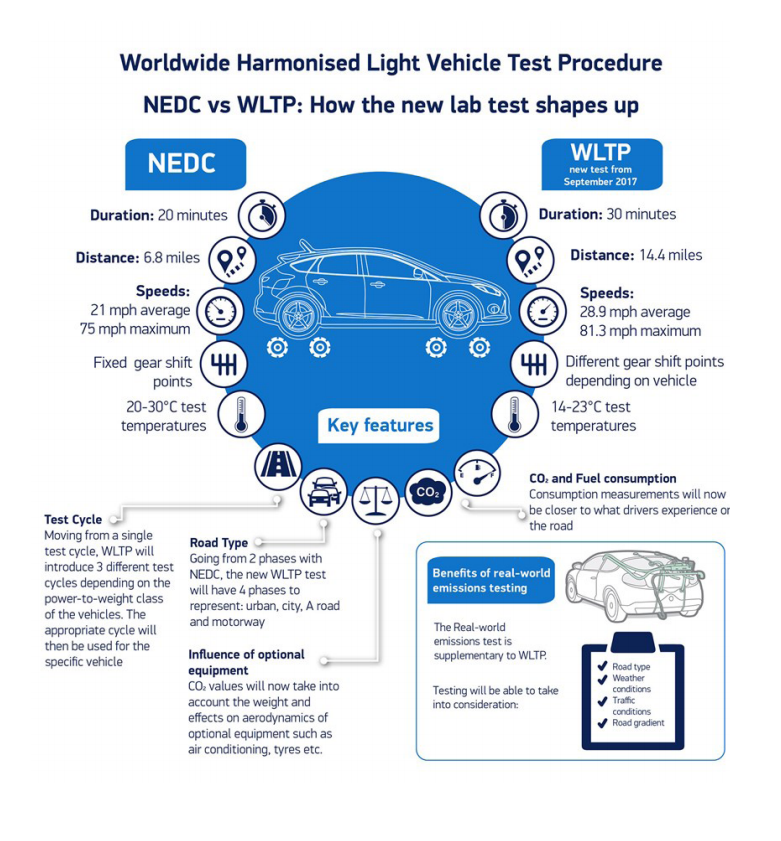What is WLTP?
WLTP is the new test procedure to measure the emissions and fuel consumption of a vehicle. It has been introduced to achieve an internationally standardised measure across passenger vehicles and light commercial vehicles that seeks to be more realistic for consumers.
What’s changing?
From 1st September 2017 the New European Driving Cycle (NEDC) test was replaced with the Worldwide Harmonised Light Vehicle Test Procedure (WLTP) for all new models of cars released to market. By 1st September 2018 all cars need to have been tested using WLTP.
WLTP vs NEDC, what are the differences?
WLTP introduces a range of new and rigorous testing procedures which seek to replicate real world driving, and more accurately align emissions to individual vehicles as opposed to providing a blanket CO2 rating for a model derivative.
Testing time is increased to 30 minutes, with four driving phases as opposed to two. Speed, gear changes and distance travelled are all increased, whilst CO2 figures are tested at lower temperatures to portray a more realistic picture of a car’s emissions cycle.
One of the most important changes relates to optional equipment on vehicles. Under the previous testing structure, optional equipment (larger alloy wheels, body styling, heated seats etc.) was not considered when assessing CO2 and MPG values.
WLTP test recognises that some optional extras will have an effect upon aerodynamics, weight and rolling resistance and will adjust CO2 and MPG values accordingly.

WILL THIS IMPACT ME?
To ensure manufacturers are able to meet their obligations and to allow time to organise the WLTP testing approval, they are stopping production on some model ranges and engine derivatives. This means that over the next 6 months some vehicles may not be available to order as they undergo this necessary update from the manufacturer.
If you aren’t due to renew your vehicle in the short-term, there is nothing for you to do – as by the time you come to place your order all vehicles will be tested under WLTP.
If you have received a renewal notification and are due to place your new vehicle order soon, continue with your renewal as normal. If your chosen vehicle becomes affected by the testing result, please contact your Account Manager to discuss further.
If you have already placed your new vehicle order, but have yet to take delivery, if your vehicle becomes affected by the testing result, your Account Manager will contact you to discuss further.
BENEFITS OF WLTP
- A greater range of driving situations (urban, suburban, main road, motorway)
- Longer test distances
- More realistic ambient temperatures, closer to the European average
- More realistic driving behaviour
- Higher average and maximum speeds and drive power
- More dynamic and representative accelerations and decelerations
- Shorter stops
- Optional equipment: CO2 values and fuel consumption are provided for individual vehicles as built
- Stricter car set-up and measurement conditions
- Enables best and worst-case values on consumer information, reflecting the options available for similar car models
The Future
After the transition is made it is anticipated that, in some cases, the WLTP test may result in a higher or lower CO2 value for a vehicle compared to the old NEDC test. This isn’t limited to any one manufacturer and any changes will be the same throughout the automotive industry. There are many reasons for this potential change:
- The driving profiles and measurement parameters for old and new test cycles differ in their method and duration
- The influence of optional equipment is factored into the newer calculation
- The conditions demanded for the new test are far more challenging than the old one
